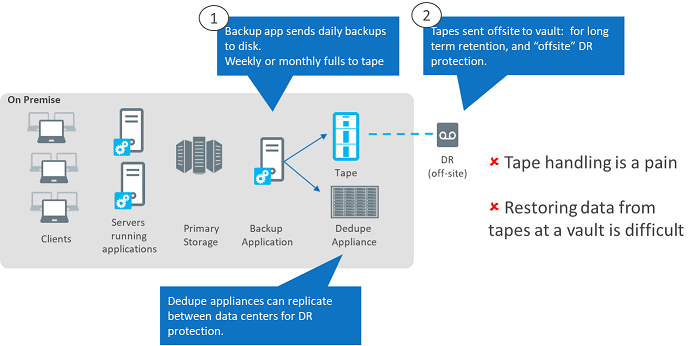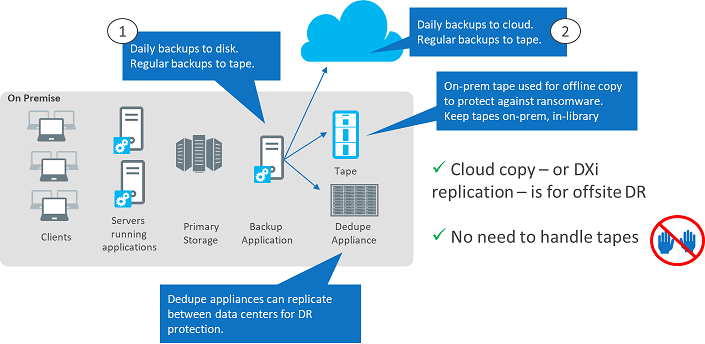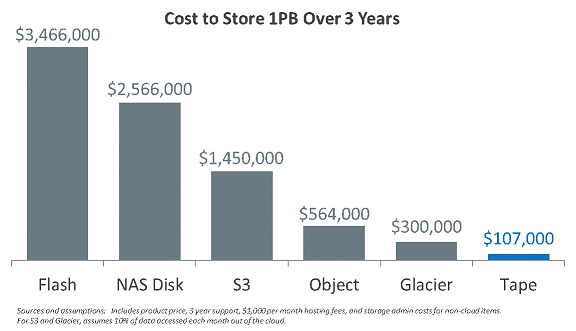
Eric Bassier is Senior Director of Product Marketing at Quantum.
When it comes to storage, I often hear people say, “We’re moving away from tape, and going to the cloud.” Cloud storage does provide some benefits over other storage options, and there are good reasons to use it. But in today’s modern storage environments, it’s not about picking one media over the other. It’s about how you use each of them. Tape and cloud can coexist. And, in fact, they should.
The Traditional Use of Tape
For years, tape has been used primarily for offsite backup and long-term retention.

As is depicted in the image, a backup application copies data to tape. Tapes are exported from the library and sent to an offsite vault to protect against a localized disaster.
This traditional use of tape comes with inherent challenges. Tape handling can be cumbersome. Physical handling of tapes and dusty storage conditions can impact the reliability of the media. If data needs to be restored, the tapes must be retrieved from the vault, loaded in the library, and then searched to find the correct files, which can be a slow, difficult process.
To address the challenges, many are turning to cloud storage. In fact, the worldwide enterprise storage market grew 34.4 percent year over year in the first quarter of 2018, according to International Data Corporation (IDC). This growth was driven in part by the demand for public cloud resources. Gartner expects public cloud services as a whole to increase 21.4 percent in 2018.
Public cloud storage is a good offsite storage solution for disaster recovery. Having backup files stored as objects in the public cloud makes it easier to restore data within the cloud. In turn, virtualized applications can be brought up quicker, thereby restoring service to users faster in the event of a disaster.
Some see this advantage as a reason to eliminate tape in their environment. But given the threat of cyber attacks and the importance of data protection, moving away from tape entirely is not the best strategy.
The Impact of Cyber Crime
Cyber attacks are an unpleasant reality. Last year, we saw SamSam, NotPetya, and other malware variants hit computers around the world, not to mention the headline-making breach at Equifax. So far this year, we’ve seen the cities of Atlanta, Georgia, and Allentown, Pennsylvania fall victim, as well as numerous health care vendors and providers, including Allscripts, Med Associates, and LifeBridge Health.
Malware attacks are persistent, sophisticated, and costly. In fact, damage from cyber crime is expected to reach $6 trillion annually by 2021, according to data from Cybersecurity Ventures. Needless to say, protecting against ransomware and other forms of malware is an important part of every information security program.
Growing cyber threats are driving the need for a new best practice for data management. For years, the best practice has followed a 3-2-1 rule—a policy based on keeping three copies of data, on two different types of media, and storing one of those copies offsite.
But given the severity of today’s cyber threats and the potential costs of recovery, the old rule is beginning to be replaced by a new best practice—the 3-2-1-1 rule. This policy is based on keeping three copies of data, on two types of media, storing one copy offsite, and storing one copy offline.
A New Use Case for Tape
Tape is the best option for offline storage. Unlike cloud storage or on-prem disk, tape is truly offline. Except when read or write operations are performed, data or backup files that are stored on LTO tape are not connected to the network. They are stored inside a tape library, offline, in a secure, protected environment. As a result, data stored on tape is not susceptible to network-based malware or ransomware, unlike cloud storage or other network-attached storage devices.
This new use case for tape as an offline storage strategy is depicted below:

In this scenario, daily backups are sent to the cloud for offsite disaster recovery instead of getting copied to tape and then boxed and shipped to a warehouse. This minimizes tape handling and eliminates the need for third-party offsite vaulting services, which can save thousands to tens of thousands of dollars a year, depending on tape volume.
Under this approach, tape fulfills the requirement for an offline storage solution. Backups are copied to tape, and the tapes are kept onsite in a tape library as a “secure, offline copy” of data to protect against malware. Since tapes remain in the library, tape handling is no longer a problem, and less handling of the tapes reduces the chances of media damage.
This strategy has cost benefits beyond eliminating the cost of third-party vaulting services. Tape is the lowest cost media, as the chart below shows:

Today, tape is no longer about offsite storage; it is about offline storage. Protecting data against ransomware and other malware attacks requires offline data protection. And tape is the most effective—and lowest cost—method of providing it.
Opinions expressed in the article above do not necessarily reflect the opinions of Data Center Knowledge and Informa.
Industry Perspectives is a content channel at Data Center Knowledge highlighting thought leadership in the data center arena. See our guidelines and submission process for information on participating.




